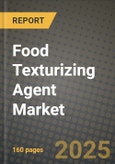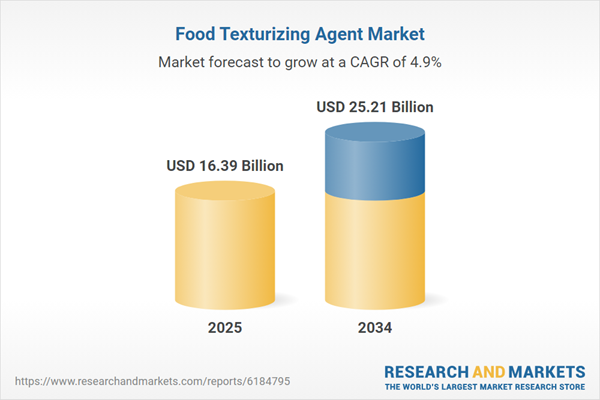Food Texturizing Agent Market
The Food Texturizing Agent market comprises hydrocolloids, starches and modified starches, proteins, fibers, emulsifiers, enzymes, and synergistic systems engineered to tune viscosity, gelation, emulsification, aeration, fat mimetics, moisture retention, and melt/chew profiles across beverages, dairy and alt-dairy, bakery and snacks, confectionery, sauces and dressings, meat and alt-meat, prepared meals, and frozen desserts. Applications range from shear-stable beverage bodies and plant-based barista foams to bake-stable crumb softness, freeze-thaw-robust sauces, elastic gummies, creamy low-fat spreads, succulence in reduced-salt meats, and bite/juiciness in plant-protein matrices. Latest trends emphasize clean-label and recognizable ingredient decks (native and functionalized starches, citrus fiber, pectin, alginate, agar, locust bean gum, guar), allergen-aware and vegan systems, sugar and fat reduction without sensory loss, protein-system compatibility in high-protein SKUs, and sustainability credentials (upcycled by-streams, regenerative sourcing, lower process energy). Growth is propelled by convenience foods, premium sensory expectations in better-for-you formats, the shift to plant proteins, and e-commerce/private-label innovation cycles. The competitive landscape blends global ingredient majors, regional botanical gum producers, specialty fermentation players, enzymatic toolkits, and custom solution blenders. Differentiation hinges on taste and mouthfeel at target usage levels, process tolerance (pH/heat/shear), label fit, supply resilience across geographies, and application science that shortens development. Vendors coupling broad portfolios with data-backed formulation guidance, pilot-plant collaboration, and credible sustainability reporting are best positioned to win reformulation and new-product briefs across retail, foodservice, and co-manufacturing channels.Food Texturizing Agent Market Key Insights
- Clean-label without compromise. Native/functional starches, citrus and oat fibers, and classic pectin/alginate systems replace legacy modifieds and synthetics while preserving viscosity, gel strength, and freeze-thaw stability.
- Protein compatibility is decisive. Texturizers must tolerate heat/pH in high-protein dairy and plant-protein matrices; enzyme-assisted approaches and targeted hydrocolloids prevent chalkiness and phase separation.
- Plant-based alt-dairy and alt-meat pull. Emulsion and gel networks deliver creaminess and elastic bite; methylcellulose alternatives (alginate/pectin with calcium, konjac, carrageenan LBG synergies) rise in importance.
- Sugar and fat reduction require layered design. Bulking fibers, low-DE starches, and micro-emulsions rebuild body and lubricity while high-intensity sweeteners handle sweetness - avoiding thin or squeaky textures.
- Process robustness is a KPI. UHT, retort, freeze-thaw, and shear events demand systems with rapid hydration, low syneresis, and thermal resiliency; pre-blends reduce operator variability.
- Enzymes unlock texture naturally. Transglutaminase, amylases, and proteases tune crumb softness, chew, and viscosity with label-friendly positioning when managed for dosage and residual activity.
- Fermentation and precision ingredients emerge. Fermented gums and tailor-made polysaccharides with narrow molecular-weight distributions enable predictable rheology at lower use levels.
- Supply security matters. Multi-origin sourcing for seaweed gums and seed crops, plus upcycled citrus/sugar-beet fibers, hedge climate and geopolitical risk while meeting ESG targets.
- Digital formulation speeds launches. Rheology databases, DoE templates, and pilot data libraries reduce trial-and-error; QR-linked COP/COA transparency supports retailer audits.
- From ingredients to systems. Turnkey blends (texture + flavor masking + stabilization) shorten commercialization and ensure cross-functional fit across processing lines and co-mans.
Food Texturizing Agent Market Reginal Analysis
North America
Reformulation in high-protein beverages, plant-based dairy, and low-sugar snacks drives demand for clean-label starches, citrus fiber, and synergistic hydrocolloid systems. UHT/aseptic lines require shear-stable solutions. Private label accelerates briefs; sustainability metrics and upcycled inputs influence retailer scorecards. Robust technical service and pilot support win RFPs.Europe
Strict additive scrutiny and clean-label preferences favor pectin, alginate, LBG, and native starches with verified origins. Sugar-reduction and fiber-enrichment programs require bulking without sweetness or off-notes. Fermentation-derived texturizers gain interest for consistency. Documentation depth, traceability, and recyclable packaging are key in procurement.Asia-Pacific
Rapid growth in RTD teas/coffees, milk-tea, and bakery drives need for quick-hydrating gums and starches with heat/acid tolerance. Plant-based categories scale in Japan/Korea/ANZ and major Chinese metros; cost-effective systems serve India/ASEAN. Local crop fibers and seaweed supply chains are strategic; halal labeling and localized applications support adoption.Middle East & Africa
Hot-climate stability for dairy drinks, desserts, and sauces prioritizes thermal and shelf-life resilience. Halal-compliant, short-deck systems and bag-in-box solutions support foodservice. Import reliance elevates multi-origin sourcing and regional inventory; training and simple dosing protocols aid consistency in dispersed manufacturing.South & Central America
Bakery, confectionery, and dairy reformulation target moisture retention and sugar reduction without losing indulgence. Native/functional cassava and corn starches provide cost-effective tools; fruit-based beverages require pectin with clarified-juice stability. Currency volatility favors local sourcing and modular blends; bilingual technical support and co-man networks accelerate launches.Food Texturizing Agent Market Segmentation
By Source
- Plant Derived
- Microbial Derived
- Seaweed Derived
- Animal Derived
- Synthetic
By Function
- Emulsifiers
- Stabilizers
- Binders
- Thickeners
- Gelling Agents
By End-User
- Bakery & Confectionary
- Meat & Poultry
- Sauces & Dressings
- Beverages
- Dairy Products
- Sports Nutrition
Key Market players
Cargill, Ingredion, Tate & Lyle, IFF (DuPont Nutrition & Biosciences), CP Kelco, Kerry Group, Roquette, ADM, Palsgaard, Jungbunzlauer, Nexira, Ashland, Avebe, Emsland Group, GelitaFood Texturizing Agent Market Analytics
The report employs rigorous tools, including Porter’s Five Forces, value chain mapping, and scenario-based modelling, to assess supply-demand dynamics. Cross-sector influences from parent, derived, and substitute markets are evaluated to identify risks and opportunities. Trade and pricing analytics provide an up-to-date view of international flows, including leading exporters, importers, and regional price trends.Macroeconomic indicators, policy frameworks such as carbon pricing and energy security strategies, and evolving consumer behaviour are considered in forecasting scenarios. Recent deal flows, partnerships, and technology innovations are incorporated to assess their impact on future market performance.
Food Texturizing Agent Market Competitive Intelligence
The competitive landscape is mapped through proprietary frameworks, profiling leading companies with details on business models, product portfolios, financial performance, and strategic initiatives. Key developments such as mergers & acquisitions, technology collaborations, investment inflows, and regional expansions are analyzed for their competitive impact. The report also identifies emerging players and innovative startups contributing to market disruption.Regional insights highlight the most promising investment destinations, regulatory landscapes, and evolving partnerships across energy and industrial corridors.
Countries Covered
- North America - Food Texturizing Agent market data and outlook to 2034
- United States
- Canada
- Mexico
- Europe - Food Texturizing Agent market data and outlook to 2034
- Germany
- United Kingdom
- France
- Italy
- Spain
- BeNeLux
- Russia
- Sweden
- Asia-Pacific - Food Texturizing Agent market data and outlook to 2034
- China
- Japan
- India
- South Korea
- Australia
- Indonesia
- Malaysia
- Vietnam
- Middle East and Africa - Food Texturizing Agent market data and outlook to 2034
- Saudi Arabia
- South Africa
- Iran
- UAE
- Egypt
- South and Central America - Food Texturizing Agent market data and outlook to 2034
- Brazil
- Argentina
- Chile
- Peru
Research Methodology
This study combines primary inputs from industry experts across the Food Texturizing Agent value chain with secondary data from associations, government publications, trade databases, and company disclosures. Proprietary modeling techniques, including data triangulation, statistical correlation, and scenario planning, are applied to deliver reliable market sizing and forecasting.Key Questions Addressed
- What is the current and forecast market size of the Food Texturizing Agent industry at global, regional, and country levels?
- Which types, applications, and technologies present the highest growth potential?
- How are supply chains adapting to geopolitical and economic shocks?
- What role do policy frameworks, trade flows, and sustainability targets play in shaping demand?
- Who are the leading players, and how are their strategies evolving in the face of global uncertainty?
- Which regional “hotspots” and customer segments will outpace the market, and what go-to-market and partnership models best support entry and expansion?
- Where are the most investable opportunities - across technology roadmaps, sustainability-linked innovation, and M&A - and what is the best segment to invest over the next 3-5 years?
Your Key Takeaways from the Food Texturizing Agent Market Report
- Global Food Texturizing Agent market size and growth projections (CAGR), 2024-2034
- Impact of Russia-Ukraine, Israel-Palestine, and Hamas conflicts on Food Texturizing Agent trade, costs, and supply chains
- Food Texturizing Agent market size, share, and outlook across 5 regions and 27 countries, 2023-2034
- Food Texturizing Agent market size, CAGR, and market share of key products, applications, and end-user verticals, 2023-2034
- Short- and long-term Food Texturizing Agent market trends, drivers, restraints, and opportunities
- Porter’s Five Forces analysis, technological developments, and Food Texturizing Agent supply chain analysis
- Food Texturizing Agent trade analysis, Food Texturizing Agent market price analysis, and Food Texturizing Agent supply/demand dynamics
- Profiles of 5 leading companies - overview, key strategies, financials, and products
- Latest Food Texturizing Agent market news and developments
Additional Support
With the purchase of this report, you will receive:- An updated PDF report and an MS Excel data workbook containing all market tables and figures for easy analysis.
- 7-day post-sale analyst support for clarifications and in-scope supplementary data, ensuring the deliverable aligns precisely with your requirements.
- Complimentary report update to incorporate the latest available data and the impact of recent market developments.
This product will be delivered within 1-3 business days.
Table of Contents
Companies Mentioned
- Cargill
- Ingredion
- Tate & Lyle
- IFF (DuPont Nutrition & Biosciences)
- CP Kelco
- Kerry Group
- Roquette
- ADM
- Palsgaard
- Jungbunzlauer
- Nexira
- Ashland
- Avebe
- Emsland Group
- Gelita
Table Information
| Report Attribute | Details |
|---|---|
| No. of Pages | 160 |
| Published | November 2025 |
| Forecast Period | 2025 - 2034 |
| Estimated Market Value ( USD | $ 16.39 Billion |
| Forecasted Market Value ( USD | $ 25.21 Billion |
| Compound Annual Growth Rate | 4.9% |
| Regions Covered | Global |
| No. of Companies Mentioned | 15 |









